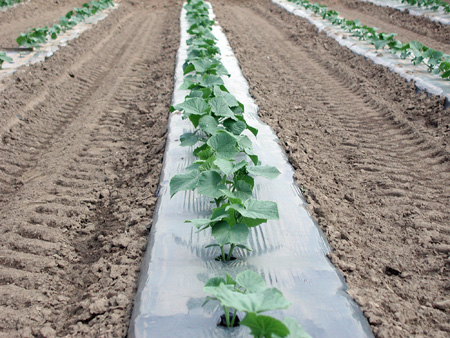Managing plastic mulches profitably
Appropriate plastic mulch type, color, and laying method helps increase soil temperature while reducing weed infestation, and crop damage.
Most fresh market vegetable growers are currently laying plastic mulches in preparation for the main season. While plastic mulch presents multiple benefits, it is also important to know that inappropriate selection and management of plastic mulch may result in crop damage or loss in revenue.
Benefits of plastic mulches
Benefits of plastic mulches are multiple and include
- Earliness: Crops grown on plastic mulch can be harvested 7 to 21 days earlier.
- Enhanced yields: Marketable yield may be up to three times greater.
- Improved quality: Produce is cleaner and has increased size and fewer culls.
- Higher economic returns: Earliness, high yields and high produce quality may improve economic return to the farmer
- Reduced weed infestation: Certain plastic mulches prevent light penetration and weed seed germination and growth, and serve as a physical barrier to weed seedlings.
- Potential decrease in disease incidence: Many foliage and fruit diseases over-winter in soil and plastic mulch may limit splash onto the plant during rain events.
- More efficient use of water: There is reduced evaporation from the soil surface, and reduced water usage as compared to overhead irrigation due to direct delivery of water to the root zone.
- Possibility to double-crop: The same plastic can be used to grow a second or third crop with minimum inputs.
- Reduced fertilizer leaching: Lower water rates, especially in light soils, reduce risk of fertilizer leaching and groundwater contamination.
Choosing the right plastic mulch for your operation
Plastic mulches are either slick with a smooth surface or embossed with a diamond-shaped pattern on the surface. Embossed films are preferred because they have reduced expansion and contraction under fluctuating temperatures, which can loosen plastic from the bed. Plastic mulches range in thickness (gauges) from 0.6 to 2.0 mils (0.0152 to 0.0508 mm). The cost and weight of the roll increases with thickness, but a 1 mil gauge thickness would be appropriate for most vegetables. The color of plastic mulch as well as light transmission and reflection affects soil temperature and weed infestation. Plastics are available in several colors, but black has so far been the major mulch used in agriculture, especially in regions with a temperate climate.

Plastic mulch with cucumbers.
Clear plastics transmit 85 to 95 percent of the incident solar radiation, resulting in the greatest soil temperature. Because they create a greenhouse effect, they are usually associated with weed problems. Use of clear plastic should be combined with an adequate weed management program. With black plastics, solar radiation is first absorbed by the plastic and then transferred to the soil as heat. Efficiency of black plastic mulches at increasing soil temperature is slightly less than clear mulches. However, because no light is transmitted, weed control is generally excellent with black plastic. White and white-on-black plastics maintain cooler temperatures and are normally used in hot environments (tropical climate) to decrease soil temperature by reflecting most of the incident solar radiation. The level of weed control depends on the opacity of the white film. Colored mulches (red, green, yellow, silver, etc.) have been tested in Michigan for tomato production but did not provide significant advantages over the standard black mulch.
Laying the mulch for optimum performance and minimum risk
A loose plastic is a serious threat to the crop, especially to young transplants because they are fragile. As indicated earlier, black mulches allow little light to pass through. They first absorb the light, which is then converted into heat. The heat is finally transferred to the soil. For greatest efficiency, it is critical to have close contact between plastic and soil. On a clear and sunny day, the black mulch surface temperature can exceed 130°F. This could result in injury or desiccation of most plant parts, such as root, stem, leaves, and fruits, in direct contact with the mulch. Crop injury can also occur even if the crop is not in direct contact with hot plastic mulch. During a sunny day, hot air builds up between the plastic and the soil. Therefore, if the plastic is loose, its flapping (even under a light wind) creates movement of hot air and funnels it through crop holes. This causes stem girdling and transplant desiccation, a problem commonly observed with young pepper transplants. Such plants become very susceptible to wind damage and should be staked and tied as early as possible. To avoid all those problems keep your plastic mulch tight on the bed.
For additional information on plastic mulches, consult MSU Extension Bulletin E-2980, Plasticulture for Michigan Vegetable Production.
Dr. Ngouajio's work is funded in part by MSU's AgBioResearch



 Print
Print Email
Email




